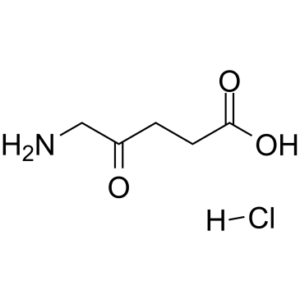Aminolevulinic acid HCl (ALA)
This product is for research use only, not for human use. We do not sell to patients.

For small sizes, please check our retail website as below: www.invivochem.com
| Size | Price | Stock |
|---|---|---|
| 50g | $750 | Check With Us |
| 100g | $1250 | Check With Us |
| 200g | $1875 | Check With Us |
Cat #: V5167 CAS #: 5451-09-2 Purity ≥ 98%
Description: 5-Aminolevulinic acid HCl (also known as ALA hydrochloride; trade name: Levulan), an FDA approved drug for treating actinic keratosis, is an intermediate in heme biosynthesis and the universal precursor of tetrapyrroles.
Top Publications Citing Invivochem Products
Publications Citing InvivoChem Products
Product Promise

- Physicochemical and Storage Information
- Protocol
- Related Biological Data
- Stock Solution Preparation
- Quality Control Documentation
| Molecular Weight (MW) | 167.59 |
|---|---|
| Molecular Formula | C5H10ClNO3 |
| CAS No. | 5451-09-2 |
| Storage | -20℃ for 3 years in powder formr |
| -80℃ for 2 years in solvent | |
| SMILES Code | O=C(O)CCC(CN)=O.[H]C |
| Synonyms | 5-ALA; ALA; dALA; 5-aminolevulinic acid; aminolevulinic acid; Aminolevulinic Acid HCl; Aminolevulinic Acid hydrochloride; US trade name: Levulan. |
| Protocol | In Vitro | 5-Aminolevulinic acid hydrochloride (ALA) is a non-fluorescent prodrug that leads to intracellular accumulation of fluorescent porphyrins in malignant gliomas-a finding that is under investigation for intraoperative identification and resection of these tumours. Median follow-up was 35.4 months (95% CI 1.0-56.7). Contrast-enhancing tumour was resected completely in 90 (65%) of 139 patients assigned 5-aminolevulinic acid compared with 47 (36%) of 131 assigned white light (difference between groups 29% [95% CI 17-40], p<0.0001). Patients allocated 5-aminolevulinic acid had higher 6-month progression free survival than did those allocated white light (41.0% [32.8-49.2] vs 21.1% [14.0-28.2]; difference between groups 19.9% [9.1-30.7], p=0.0003, Z test) . |
|---|
These protocols are for reference only. InvivoChem does not
independently validate these methods.
| Solvent volume to be added | Mass (the weight of a compound) | |||
|---|---|---|---|---|
| Mother liquor concentration | 1mg | 5mg | 10mg | 20mg |
| 1mM | 5.9669 mL | 29.8347 mL | 59.6694 mL | 119.3389 mL |
| 5mM | 1.1934 mL | 5.9669 mL | 11.9339 mL | 23.8678 mL |
| 10mM | 0.5967 mL | 2.9835 mL | 5.9669 mL | 11.9339 mL |
| 20mM | 0.2983 mL | 1.4917 mL | 2.9835 mL | 5.9669 mL |
The molarity calculator equation
Mass(g) = Concentration(mol/L) × Volume(L) × Molecular Weight(g/mol)
Mass
=
Concentration
×
Volume
×
Molecular Weight*
The dilution calculator equation
Concentration(start)
×
Volume(start)
=
Concentration(final)
×
Volume(final)
This equation is commonly abbreviated as: C1 V1 = C2 V2
Concentration(start)
C1
×
Volume(start)
V1
=
Concentration(final)
C2
×
Volume(final)
V2
Step One: Enter information below
Dosage mg/kg
Average weight of animals g
Dosing volume per animal µL
Number of animals
Step Two: Enter the in vivo formulation
%DMSO
+
%
+
%Tween 80
+
%ddH2O
Calculation Results:
Working concentration:
mg/ml;
Method for preparing DMSO master liquid:
mg
drug pre-dissolved in
µL
DMSO(Master liquid concentration
mg/mL)
,Please contact us first if the concentration exceeds the DMSO solubility of the batch of drug.
Method for preparing in vivo formulation:
Take
µL
DMSO master liquid, next add
µL
PEG300, mix and clarify, next add
µL
Tween 80,mix and clarify, next add
µL
ddH2O,mix and clarify.
Note:
- (1) Please be sure that the solution is clear before the addition of next solvent. Dissolution methods like vortex, ultrasound or warming and heat may be used to aid dissolving.
- (2) Be sure to add the solvent(s) in order.




































